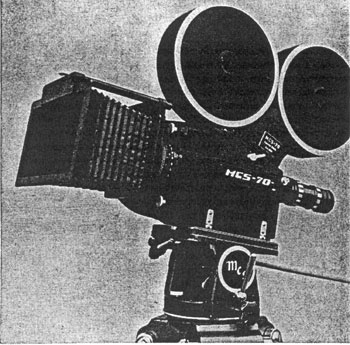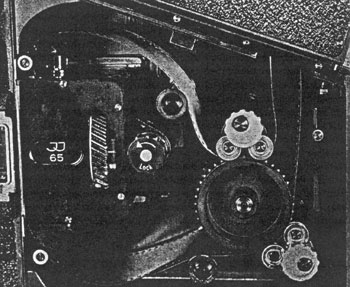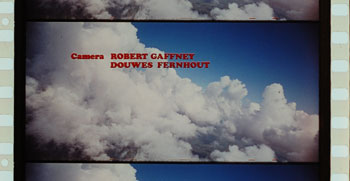Footnotes To The Production Of "Motion" And "Sky Over Holland" By Robert Gaffney, Director Of Photography |
Read more
at in70mm.com The 70mm Newsletter |
| Written by: American Cinematographer, August 1967 | Date: 12 September 2006 |
 The overworked word "intrepid" applies most precisely to
cameraman Gaffney. He is shown nonchalantly draped over the rail of an
iceboat to operate the 70mm camera as skittish craft is about to take
off over the ice at tremendous speed. Sequence appears in “Sky Over
Holland”, which I s part of Netherlands EXPO exhibit. However, since
Dutch pavilion has no 70mm projection facilities, pictorially beautiful
film is shown only two evenings a week in CN Pavilion theatre. The overworked word "intrepid" applies most precisely to
cameraman Gaffney. He is shown nonchalantly draped over the rail of an
iceboat to operate the 70mm camera as skittish craft is about to take
off over the ice at tremendous speed. Sequence appears in “Sky Over
Holland”, which I s part of Netherlands EXPO exhibit. However, since
Dutch pavilion has no 70mm projection facilities, pictorially beautiful
film is shown only two evenings a week in CN Pavilion theatre.The camera used for the filming of both the Canadian National film, “Motion”, and the Netherlands film, “Sky Over Holland”, was the M.C.S. 65mm Reflex Camera. Lenses consist of a full complement ranging from 600mm to 17˝ mm wide-angle. The camera was designed by Jan Jacobsen, who has also built a 65mm hand held, fully blimped camera with a lens covering 150 degrees. There is only one prototype of this model, and I have not seen or used it, but my assistant, Dieter Giebler, from Munich, has used it and states that it is quite good. The lenses are of the following manufacture: 17˝ mm - Jan Jacobsen special built 21 mm - Jan Jacobsen special built 25 mm - Enna 37 mm - Enna 52 mm - Angenieux 80 mm - Carl Zeiss 100 mm - Cannon 135 mm - Kilfitt 600 mm - Kilfitt The camera itself is of very simple design and rugged construction. It has with it 1000-foot and 500-foot magazines, matte-box, sunshade, variable speed motor, and sync motor. With additional motors, I have run this camera successfully from 1 through 40 F.P.S. To run at high speeds some gear changing must be made, but it can be done. All of the extra motors are used by piggy-backing them on the main variable speed motor. Thus, the sync motor is very small and light as the main drive motor is doing all of the work, while the sync motor is sort of a hold-back. The camera runs on a 16-volt Arriflex battery, and does quite well even under very cold conditions, as there is only one gear in the main drive system. The rest is done by gilmer belts. The temperature when going out of the airplane at 14,000 feet for the sky diving sequence was -15 degrees F, and there was only one battery running the camera at 30 F.P.S. |
More
in 70mm reading: The Passing of Bob Gaffney, 1931 - 2009 "Sky over Holland" Film Credits "Motion" MCS 70 - Superpanorama Jan Jacobsen "Fanny's Wedding" Internet link: Sherry's Keepsakes Bob Gaffney on imdb.com Robert "Bob" Gaffney (08.10.1931) |
 The MCS 70mm reflex camera, used to photograph “Motion” and
“Sky Over Holland”. Designed by
Jan Jacobsen,
camera is of simple design and rugged construction. New hand-held
version is much more compact and lighter in weight. Camera runs on a
16-volt battery, accommodates lenses ranging from 17˝ mm to 6OO mm. The MCS 70mm reflex camera, used to photograph “Motion” and
“Sky Over Holland”. Designed by
Jan Jacobsen,
camera is of simple design and rugged construction. New hand-held
version is much more compact and lighter in weight. Camera runs on a
16-volt battery, accommodates lenses ranging from 17˝ mm to 6OO mm.The camera body itself has all the standard three- eights-sixteen screw holes for mounting on American heads and tripods. The viewing system, while not as classy as that of the new Todd-AO hand-held reflex camera, is quite good. It affords an excellent image on all the lenses down to the 52mm. Then, there is same cut-off in the viewing due to the barrel of the wide-angle lens entering the light path of the 45-degree reflection to the ground glass. However, this is minimal. It occurs on the left side of the frame, looking at the image erect, and only covers one/seventh of the field on the 37mm, 25mm, 21mm, and 171hmm lenses. These lenses are used mostly for those effect shots where looking through the camera, except for initial set-up, are quite impossible. There were many interesting and difficult situations during the shooting of both films. The sky diving presented the biggest challenge for me. Most people in the business would say, "Why not give up and shoot it 35mm squeeze". Like Lin Dunn, I am a 70mm nut, and always will be. No one will ever convince me that Technirama, Techniscope, etc. (including 35mm Panavision) can ever match the quality of a good 65mm negative. The N.A.S.A. 35mm Panavision material in the “Motion” film does not begin to compare in quality with the 65mm material. Also, in any kind of squeeze system, the lenses are not wide-angle enough to do some of the things that are essential in my kind of filming. For example, what lens could I use when the only place available to mount the camera on an aerobatic airplane places the lens 14 inches away from the pilot's head? I have never heard of a squeeze lens equivalent to the M.C.S. 21mm or 25mm spherical lenses. It would have to be a 10 mm anamorphic! |
|
 With door open, extremely simple threading pattern of M.C.S. camera is
revealed. Though movement is of simplified design, picture it produces
is rock-steady on the Screen. Camera held up well under the most
demanding conditions, including repeated drops from aircraft. With door open, extremely simple threading pattern of M.C.S. camera is
revealed. Though movement is of simplified design, picture it produces
is rock-steady on the Screen. Camera held up well under the most
demanding conditions, including repeated drops from aircraft.We decided for whatever reasons to stick to the 65mm format. The story of the free-fall filming is pretty accurately covered in the preceding article. The technical part of it is another story in itself. When we decided not to try any more jumps with the camera tied to the sky diver, we had to build a device for the camera to free fall by itself. This was not easy, as we only had one camera, which was constantly being used on the production. The next best thing was to make a mold of the camera and send it ahead of us to California, so that work could begin on the free-fall rig. As it turned out, I finished shooting the rest of the film before the camera mold was ever needed. It took 2 months to figure out the right shape to drop so that it would fall at exactly the right speed. Once the shape was determined, the rest was just a matter of waiting nervously on the ground for the chute to open. The camera seemed to have an affinity for landing at least one mile away {sometimes more) from the nearest road where we could get in with a jeep. The winters in northern California are quite wet: Hand carrying the 195-pound camera system out of muddy fields for a mile or more got to be a running gag. The sky-divers, of course, could steer their chutes to the road. They would then say to me, "Gaffney, your camera is out there in the field". The camera, with the 500-foot magazines, weighs about 55 pounds. When I told the dragster driver that I wanted to mount the camera up front on a welded steel stand 4 feet off the ground facing him, he gulped hard, and said he would do it if his own man did the welding. When the welding job was finished, the driver approved it, and said that we had better film on the first run because "these crazy dragsters can blow an engine rather easily". Off he went without even feeling how the car would react with all the extra weight out front-from stand-still to 200 MPH in 13 seconds. The car gave one short agonizing swerve; the driver straightened it out, and went for the rest of the run. We then moved the camera to the position over his shoulder for the reverse, and I'll be damned if he didn't match the same swerve. Afterwards he informed us that he thought "You'd like a little of the same action in the second shot", even though I hadn't had the nerve to ask him to repeat his former act. |
|
 In the Dutch picture, “Sky Over Holland”, everyone wonders why,
during the sea scenes, there was no water on the lens. "We have worked
out a very simple device which is completely foolproof. We can shoot
during mist, spray, waves hitting the camera, driving rain, and
you-name-it. The lens remains absolutely clean and clear. I am not
permitted to go into any more detail just now, as the patents are still
pending, but I will say merely that it is a simple operation requiring
little extra equipment and it can be run off the camera battery. In the Dutch picture, “Sky Over Holland”, everyone wonders why,
during the sea scenes, there was no water on the lens. "We have worked
out a very simple device which is completely foolproof. We can shoot
during mist, spray, waves hitting the camera, driving rain, and
you-name-it. The lens remains absolutely clean and clear. I am not
permitted to go into any more detail just now, as the patents are still
pending, but I will say merely that it is a simple operation requiring
little extra equipment and it can be run off the camera battery. |
|
|
Go: back
- top - back issues
- news index Updated 21-01-24 |
|
